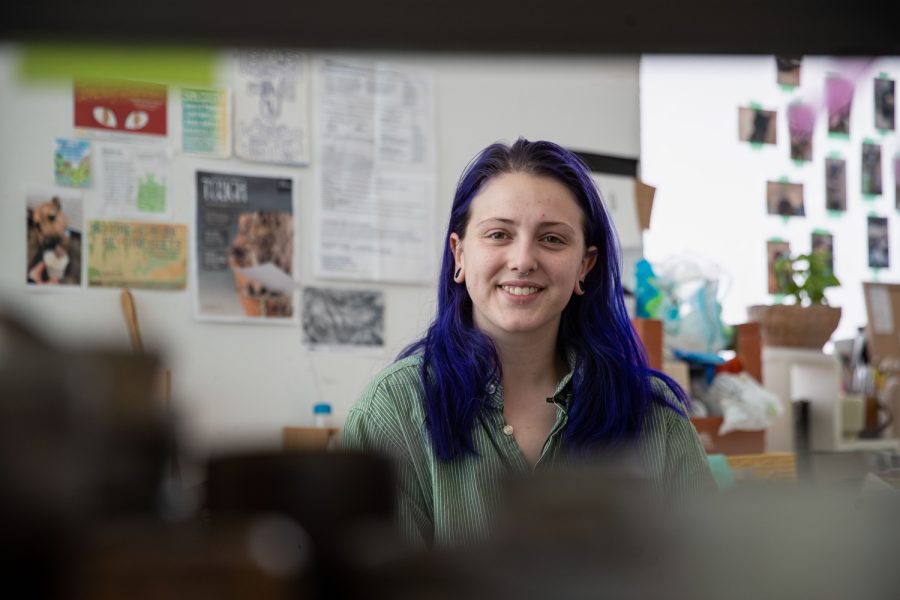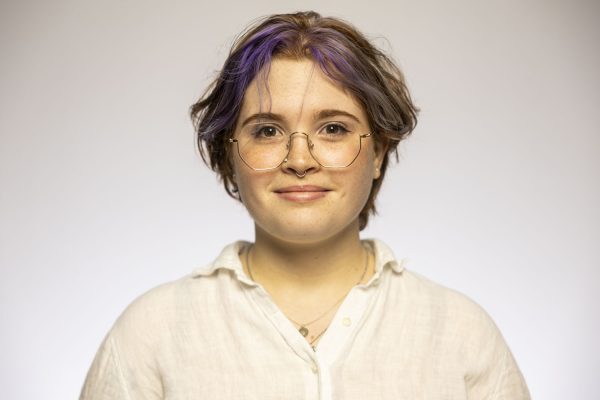Student Spotlight: Ceramics student’s exhibit displays wood-fired pottery, plays with ash and identity
Eliza Link plans for her pottery to outlive her. A Bachelor of Fine Arts student studying ceramics and art history, Link focuses on the relationship between art and legacy and how that relates to her own identity.
Iowa senior Eliza Link poses for a portrait on Friday, April 28, 2023. Link has been a ceramic artist for eight years.
May 2, 2023
Pottery, rock engravings, and pictographs are art forms from ancient civilizations that still exist but are rarely practiced. One ceramics student goes beyond tradition by exemplifying ancient and prehistoric techniques in her recent exhibit “Smells Like Smoke.”
“Smells Like Smoke” took place in University of Iowa Visual Arts Building gallery from April 17-22. Bachelor of Fine Arts student Eliza Link explored remnants of the past and other themes through the history of clay techniques. The exhibit displayed almost 100 original pieces of pottery.
Link is a double major in studio arts for ceramics and art history with an entrepreneurial business management certificate, which she said is a lot to manage in four years. Link spoke about how her time at the university inspired this exhibit.
“I had the busiest semester I have ever had. It was one of those times where you wake up in the morning and you go and go until you collapse into bed,” Link said. “I really started to think about how all of your days add up to what your life becomes, and that’s terrifying. You have to be really intentional about how you take advantage of that time as you live it because you don’t get it back.”
Throughout her experience learning about art history at the university, Link felt connected to artists of ancient societies.
“It was a real struggle to live and to survive then.” Link said. “And through all of that, people and cultures over generations developed ways of making art and places to make art, including new technologies like lamps and scaffolding and different kinds of paints, and then devoted time and resources amidst the struggle to survive to make art.”
“Smells Like Smoke” has been in development for over five years. However, most of its featured pottery was made over the last year and six months. Link coordinated and managed two separate kiln firing sessions where all the pieces were complete. The first one was 50 hours of rotation, and the second was 72.
Kilns are chambers made of non-melting materials meant to pressurize and heat up ceramics to bake clay and make it stronger. Contemporary kiln-firing uses gas, electricity, or other modern fuels to provide heat. Link used the ancient technique of wood firing to complete her pottery.
Most of her pottery has no glaze, which is an additive to dip pottery into before it goes into the kiln to protect it from the harsh environment the kiln provides. Because wood firing is unpredictable, Link and a team of other ceramics continuously monitored the kiln to adjust the flow of air intake to ensure balance and the success of the pottery.
All of the pottery, including vases, cups, mugs, and bowls, was ashy and organic in color, with gray and brown hues. On the floor were scattered ashes and broken bits of pottery. Ashen handprints were on the walls and podiums.
“Thinking about the historical context, thinking about my fingerprints on everything that I do, and how somebody else can hold my hand in that way,” Link said. “I’ll continue to slowly evolve this work in a lot of ways, and I can see myself going in this direction for quite a long time.”
Scattered on the walls were also the definitions of the words smoke, archaeology, semiotics, and legacy. These four words develop into Link’s thesis.
“Smoke is the evidence of what we have; of the processes that are occurring just like the work is. Archeology is the process of analyzing that. Semiotics is a tool that you can use to analyze the work, and then the legacy is what you deduce from it,” Link said.
Link added that she wanted to leave her mark on the world forever through her pottery.
“I’ve been thinking a lot about what the future will know of me long past when I am gone,” Link said. “All of this work will never degrade. It will break. It will get buried. It will turn into other things. It’ll go to Goodwill. It will end up in somebody’s grandma’s basement, but it’s never going to turn back into dust unless somebody tries really hard.”















